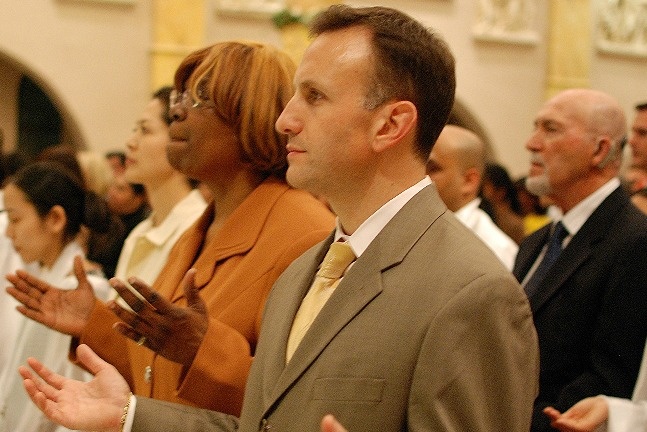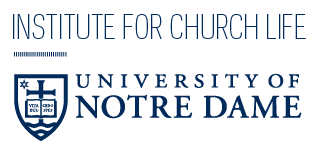I used to think that the Prayer of the Faithful was a bit like a bill passed in Congress. There would be certain key prayers, followed by additional prayers from special interest groups that might not have been part of the original plan, but after a vote from the parish committee on Sunday all of us are obliged to stand and repeat, “Lord, hear our prayer,” regardless of whether we were particularly connected to these prayers. However, in reality these prayers are one of the most important duties of our Christian life, and a necessary work for our salvation and that of the world.
First, from the General Instruction of the Roman Missal:
In the Prayer of the Faithful, the people respond in a certain way to the word of God which they have welcomed in faith and, exercising the office of their baptismal priesthood, offer prayers to God for the salvation of all. (§69)
What is striking here is that the Prayer of the Faithful is one of the ways that we exercise our shared baptismal priesthood. The new life that we experience in our Baptism brings with it new authority and responsibility, especially a priestly responsibility. And there are several observations to be made about our what this priestly responsibility entails.
As David Fagerberg points out in his Liturgical Theology, Adam and Eve had a priestly duty to God. Even though they were taught to rule over all creation, they had the requirement to give each animal and thing a name. By naming that animal they return it to God, and offer its existence not for their own purposes but ultimately for God’s. Within our Baptism, we are now Adam and Eve redeemed, and our responsibility is to bring all of creation with us and name that before God in our prayers. In the Prayer of the Faithful we do something similar; we name before the altar of God the intentions that we have for the Church, for civil authorities, for those with difficulties, for our local communities, and many more.
The basic work of the Christian priest is as follows:
- Offer up our praise / gifts (anaphora),
- Ask God to remember his covenant (anamnesis),
- Call down God’s presence upon the gifts (epiklesis),
- Commune with God and bring God to others.
If we take a look at the Prayer of the Faithful, we see that we ourselves have the same structure present.
- The priest celebrant begins with a prayer, calling us to offer up our petitions (anaphora).
- We ask God to remember his care of all creation by naming them before him (anamnesis).
- We ask God to grant these petitions of his grace in the world (epiklesis).
- We go out and take action.
While there is certainly room for improvisation, the Roman Missal currently has many examples in its appendix that essentially provide a script for this same structure. Here is an example of the opening prayer for the Prayer of the Faithful from Advent:
As we await with longing
the coming of our Lord Jesus Christ,
dear brothers and sisters,
let us with renewed devotion beseech his mercy,
(call to offer up our prayers—anaphora)
that, as he came into the world (remembering—anamnesis)
to bring the good news to the poor
and heal the contrite of heart,
so in our own time, also,
he may bring salvation to all in need. (calling down his grace–epiklesis)
The priest celebrant essentially gives us the structure for what we are about to do. We then do the work of naming our petitions before God, followed by an emphatic call to God to bring his mercy into the world through Jesus Christ, an epiklesis.
Almighty ever-living God,
who bring salvation to all
and desire that no one should perish,
hear the prayers of your people
and grant that the course of our world
may be directed by your peaceful rule
and your Church rejoice in tranquility and devotion.
Through Christ our Lord.
Amen.
Note that the Advent prayers are designed uniquely to respond to the Advent readings and the meaning of the Advent season. As Scripture penetrates our hearts through the readings in the various seasons throughout the year, likewise our hearts respond differently to God in this time than others. The prayers are our first active response to these readings, they are our first act of love in response to the readings. Thus our own priestly activity of prayer also follows the Church’s calendar.
Finally, notice the most important part of this prayer, “Through Christ our Lord,” which is so often overlooked because it is so common. By offering the petitions to God the Father through Christ our Lord, the priest celebrant takes them and unites them with sacrifice of the Mass. To understand the importance of this, consider the prayer of the good thief on the cross: “Jesus, remember me when you come into your kingdom.” I marvel at what a perfect prayer of petition this is; it is a prayer of one who knows he is a sinner, but has faith in the mercy of almighty God. By uniting our prayers with Jesus’ sacrifice, the priest effectively places these prayers at the foot of the Cross, and we ask these things of Jesus, knowing how much he has already done for us. That should give us pause to consider the powerful act we are doing and the humility we may have in offering these prayers.
The Prayer of the Faithful is where we the laity exercise one of the highest priestly functions in our vocation, our restored dignity as priests given from the moment of our creation. These prayers are the moment when we drag the world with us and call God to account for his loving care for creation and of our greatest needs and petitions. By doing the work of prayer we sanctify the world, calling down God’s Holy Spirit onto the myriad needs and desires of his Church. We do all this in light of the Cross, keeping Jesus’ sacrifice in mind at every point. That may be the most important aspect to keep in mind for restoring our sense of humility, our sense of ‘chosenness’ to do this work, and allowing us to offer this work to Jesus in light of his sacrifice for us.
Alan Stout is an independent writer and marketer living in Pamplona, Spain. He holds an MTS in Liturgical Studies from Notre Dame '13, and also blogs at Worship With Integrity and the Well Balanced Marketer.



